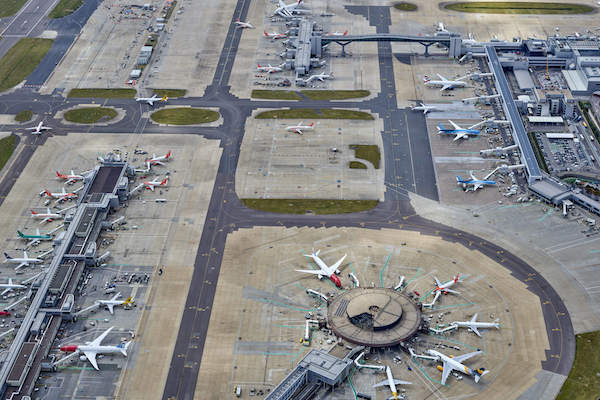
The “New Reality” is a phrase I hear often as we emerge out of lockdown and businesses not only try to comprehend the immediate impact of the crisis, but also how COVID-19 will change our economy over the longer term.
In terms of headline numbers, our recent analysis found that the South East would see 2020 GVA growth of -7.4%.
However, delving deeper into the numbers showed a mixed bag for our region with those economies most reliant on transport manufacturing, travel and international tourism likely to see the greatest economic damage this year.
Areas such as Crawley could see GVA growth fall to minus double dig- its this year, as the full impact of the crisis on airports and its supply chain take hold. But other places such as Reading, Worthing and Epsom will see growth fall by less than -5%, being least affected due to the prominence of pharma and professional services firms.
Open for business?
From issues around transport, a safe return to the workplace and employment, to technology and the survival of both small and large businesses, re-opening the South East presents some big challenges but also an opportunity to accelerate and address some of the key issues that have been holding the region back for years.
The lockdown has amplified two pre-COVID trends -
(1) Technology developments – such as automation, data proliferation, industrial revolution 4.0 and the emergence of software as a service; and
(2) Population dynamics, such as increased life expectancy, focus on health and wellbeing, and life-long learning to support multiple careers.
What COVID-19 has done for our regional business leaders and policy makers has given them a new perspective and, possibly, an opportunity to reshape their operations in response to these trends.
Technology is the future
Most businesses had a digital strategy in play, but their ‘technology debt,’ as I like to call it, was high. This ‘debt’ is the underspend in technology that businesses have been going through over the last few years. And yet, the way in which technology has taken centre stage in recent months has accelerated the tech agenda.
Businesses of every size and sector across the region are looking to work more effectively, embed more technology and become leaner as they return from lockdown. Digital channels will become key for engaging with customers, while automated processes will become a primary driver of productivity—and the basis of flexible and more efficient supply chains.
During lockdown, we saw organisations collaborating in order for their businesses to operate. With digital strategies now taking centre stage, the innovation that sits with our start- up and scale-up community will be vital to our success and it’s important they are showcased and introduced to businesses that could benefit from their skills, insight and technology. The region is positioned well to leverage its strength in high growth, technology-powered industries and highly skilled talent pool.
The pandemic has also hyper accelerated the need for local businesses to retrain and re-skill its working population with digital skills. With a strong tech community, we are in a good position to be a UK leader in this - which will have a positive impact on the economic and societal issues that the region faces.
A particular challenge that I would like to see tackled is how private sector business leaders can collaborate with the public sector, whether that is Local Government, LEPs and the higher education sector, to deliver the skills we need. There is also an opportunity to reshape Further Education as universities will need to review their business models, which have traditionally relied so heavily on overseas students.
The future of work
A key legacy of the pandemic will doubtless be a sustained rise in working from home. This has the potential to benefit the country’s regional economies through a re-drawing of the geographical limits on our labour markets.
It offers opportunity for employers in the South East and local talent to interact more widely, creating labour markets perhaps two or three times the previous size, stimulating an opportunity and productivity boost on the back of a more fruitful skills market.
Access to opportunity and regional productivity could be boosted by an enlarged talent pool for employers and a greater commutable area for ambitious employees.
We may also see more diverse regional economies evolve as firms are able to establish new offerings, confident that they will be able to attract the right skills without them being on their doorstep.
Business leaders are already looking at how jobs are realigned to skills and task, rather than traditional job roles, and there is a recognition that employee skills will be fluid and will change to meet new roles that emerge, or respond quickly to market disruption. In time, other key considerations will include how organisations shape, plan and monitor their workforce, drive its performance using data, and attract and retain the best resource.
The role of policy makers
Long before Coronavirus, the Government had put regional growth at the heart of its economic agenda.
In a post COVID-19 world, the need for spend on infrastructure and to build stronger regional economies is even more important.
City regions have become effectively smaller and conversely, from a practi- cal perspective, functional economic areas will get bigger. These outcomes will result from a change in our approach to being in the workplace, as a proportion of the workforce will commute less frequently in the long term. As seen in the pandemic, communities and place played a key part in lockdown and this trend will continue with more people heading to local high streets and supporting local businesses rather than travelling further afield. This sense of community is a great time for policy makers to boost their local economies.
Businesses will need to work more closely with policy makers to give them insights to trends in demand, employment, recovery and how people are working in order to shape more effective policies around transport, skills and commercial property to meet the new world reality in the South East.
We could also see better collaborations between LEPs to strengthen intra region connectivity and access to economic hubs, for instance drawing on the Oxford-Cambridge arc, which is supported by four LEPs in the South East region.
Finally, we must not forget the ele- phant in the room. Through the intervention measures the government has “invested” heavily in the SME market, whether through CBILS and/or the Job Retention Scheme.
As this unwinds, there potentially will be greater influence that can be exerted on companies that were recipients of the intervention, whether that is through pushing ahead with the ESG agenda, a review of companies that claimed on JRS and how to repay the guaranteed debt – buyer beware!
We have much to get through in the short term, but if we can take a mo- ment to indulge ourselves in looking to the future, I do see a productivity op- portunity to come from this crisis and the region has the chance to emerge stronger in the ‘new normal’ – whatever that eventually looks like.
Tel: 01293 652705 www.kpmg.co.uk





